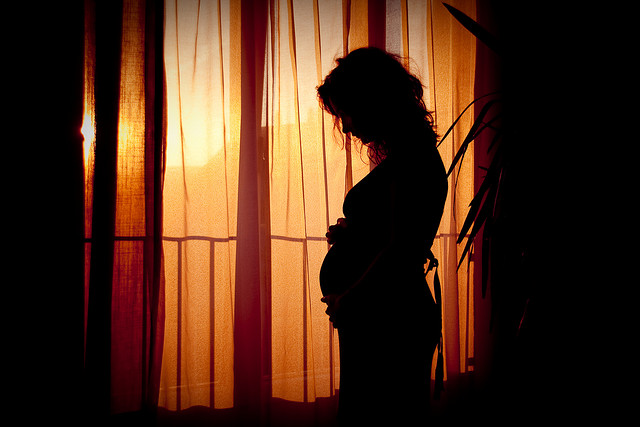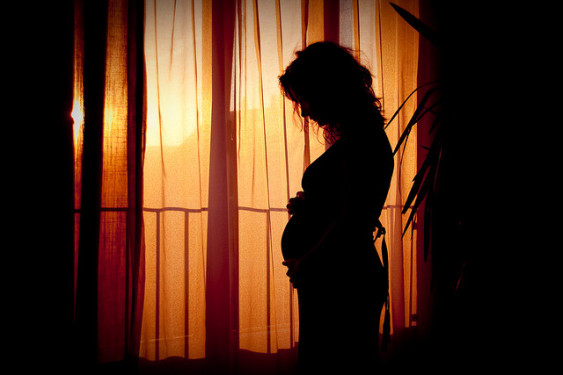More than 80 percent of teen pregnancies are accidents. A girl with other hopes and dreams—or maybe a girl who is floundering, who hasn’t even begun to explore her hopes and dreams—finds herself unexpectedly slated for either an abortion or 4,000 diapers. Given the shame and stigma surrounding abortion in many American subcultures, that can seem like a choice between the proverbial rock and hard place. The exciting news that launched this Sightline series is that teen pregnancy is in decline across the United States and across all major ethnic groups. Fewer and fewer young women are facing hard decisions after the fact.
All the same, America continues to have the highest teen pregnancy rate of any developed country, and Canada looks stellar only when compared to the States. Even in Cascadia, which is better off than most regions, several thousand babies are born each year to girls between the ages of 15 and 17, and thousands more to young women aged 18 or 19 (e.g., Oregon 2012, Washington 2012, British Columbia 2010). Across the United States, almost 1,000 infants are born to teens each day. And approximately 30 to 50 percent of teen girls who give birth will experience a rapid repeat pregnancy within 24 months, which multiplies medical complications and the risk of lifelong poverty.
Economic Inequality
Early unplanned childbearing widens the gulf of income inequality. Pregnancy often compels girls to drop out of school, and fewer than 40 percent of those who give birth before graduating go on to complete high school by age 22. In a survey of high school dropouts aged 19–35, only 17 percent held full-time jobs, and half of those employed said they had no opportunity to advance beyond their current position. By age 25, even those who do work full time earn 30 percent less than their peers who completed high school and 60 percent less than college graduates. Their loss of productivity and income has been called a permanent recession.
Racial Justice
Early unplanned childbearing also widens racial disparities. Birthrates for black and Hispanic teens are more than double that of their white peers and quadruple the rate for Asian/Pacific Islanders. Since the birthrate is highest among Latinas, some people assume that early childbearing is simply a cultural norm. But a wide-ranging survey of US Hispanics found that Hispanic parents had other dreams for their daughters, and so did the girls who ended up pregnant. In the words of one advocate, Ruthie Flores, “There’s a big disconnect between pregnancy rates and what Latina families want and value.”

Two girls by Eddy Van 3000 used under CC BY-SA 2.0
Part of the problem may lie in a generation gap that brings together old-country gender scripts with American teen behavior. Latino teens look to older relatives for values and advice, but also say that the main reason kids don’t use birth control is that they’re afraid of their parents finding out. Some Dominican girls have told providers that they can’t use a hormonal IUD because their mothers and aunts vigilantly monitor their periods. (Note that hormonal IUDs are thought by some experts to be the best contraceptives on the market because they combine high efficacy with low hormone load and non-contraceptive health benefits, including lighter periods and protection against some cancers.)
Unfortunately, parental vigilance may be more effective at preventing contraception than it is at preventing sex or safeguarding dreams. Community leaders are working to empower young mothers while also lowering barriers to high-quality family planning services.
Public Costs, Personal Struggles
The hard-nosed economist who simply wants to balance public budgets can point to the fact that in 2010 Washington State spent an estimated $124 million on teen childbearing, which illustrates the scale of costs across the region. But beneath that statistic lie individual stories of hardship: a premature infant in an incubator, a young mom’s struggle to find housing or pay for diapers, her days at home while her friends are in school, her sleepless nights when other teens are sleeping till noon. “My friends couldn’t even begin to fathom what was going through my mind or how scared I was,” says Triciah Drawbaugh, who gave birth at age 17. “It’s weird thinking about it. I try to forget about it. That’s how awful it was.” Other young mothers speak candidly on MTV’s 16 and Pregnant: they may love their babies dearly, but few wish the experience of early unexpected childbearing on others.
Policy Recommendations
If Cascadia broadly is to attain a teen pregnancy rate as low as that of Europe, we have work to do. But we now know how to go about it, as earlier segments of this series have shown. By combining evidence-based practices such as comprehensive sex ed, affordable care that meets teens where they are, counseling techniques that respect young women and help them to explore their own goals, and state-of-the art long-acting reversible contraceptives, we can make planned, wanted, healthy childbearing the norm for young women.
The primary challenge at this point is simply one of breaking old habits. But old ways of doing things get formalized through cultural norms and institutions, which can be hard to change. Outdated approaches have been scripted into not only conversations between parent and children, but also high school health curricula, medical practice, insurance reimbursement contracts, and even public policies and funding streams. This means that change must occur at all levels.
Health Education
In her second week of first grade, Danielle announced after school that she knew where babies come from. “Oh?” responded her mother, trying to sound casual. “Yes!” said Danielle. “A boy puts his peener in your wiener, and it makes a baby.”
Fifteen-year-old Mary attended a small-group discussion in which women shared their abortion stories. To her surprise, the mother of a schoolmate was part of the group. As the conversation unfolded, she talked about her unexpected pregnancy as a young teen. “I’m waiting to tell my daughter when it feels like the time is right.” Afterward, Mary confided to her own mom. “It’s really weird—I know that her daughter is having sex, but her mom thinks she’s not ready.”
If kids and teens are to get thoughtful, accurate information from adults rather than peers, education needs to start early.
- Introduce age-appropriate reproductive health concepts in grade school, with an early emphasis on safety and wellness.
- Engage parents so that they can be effective advisors to their children.
- Replace abstinence-only education with comprehensive sex ed for reproductive-age students.
Medical Practice
Elise first heard about hormonal IUDs from a medical student who had one, and as a teen athlete she loved the idea of lighter periods. Her mother loved the idea of highly effective birth control that would last all the way through college. But when Elise brought up the idea to her family doctor, the doctor launched into horror stories about women “bleeding clots the size of fists.” She instead recommended continuous oral contraceptives or the Depo-Provera shot. Skeptical, Mom persisted and scheduled Elise with a specialist, the ob-gyn who had delivered her. There they discussed the latest research about teens and contraception, and Elise decided to go ahead with an IUD. Six months later, Elise was evangelizing her friends.
Claudia worked as a family court judge, and one of her more painful duties was making judgment calls about parental rights for teen moms. When girls came into her courtroom, she routinely inquired about their pregnancy intentions. “I’m on the pill,” many would say. But when Claudia asked, not one in 17 years said that she had actually taken a pill that morning. Expenses, forgetting, substance abuse, and life chaos trumped the best of intentions.
Busy doctors sometimes struggle to keep up with changing practice standards in reproductive health and may fall back on outdated information or familiar birth control methods that are easy to prescribe but harder for teens to use.
- Get the word out to primary-practice “gatekeepers” that long-acting reversible contraceptives are safe for teens and dramatically reduce unwanted pregnancies.
- Integrate family planning into other adolescent medical services, including primary care and management of chronic illness.
- Increase school-based health services.
- Train providers in client-centered counseling coupled with tiered presentation of contraceptive options—most effective first—and make this the standard of care.
- Update clinic practices to allow longer initial family planning appointments with less frequent follow-up, as befits longer-acting top-tier methods.
- Eliminate unnecessary delays and return visits so that patients can receive the method of their choice in a single visit.
- Integrate reproductive life planning into prenatal care and provision of long-acting reversible contraceptives into labor and delivery services for women, including teens.
Insurance and Medicaid Reimbursement

(Untitled) by Navy Blue Stripes used under CC BY-NC-ND 2.0
Janet works in a clinic that serves low-income women in Memphis, Tennessee, where top-tier birth control is available with no copay, thanks to a local foundation called A Step Ahead. Irene came to see Janet because she learned about the program from a counselor at her welfare office. She hoped to leave with an IUD that day—transportation and child care were difficult—but reimbursement rules required the clinic to order the expensive devices individually for specific patients rather than stocking them ahead of time. Janet ordered an IUD, but Irene didn’t show up for the follow-up appointment.
Barriers that may seem small to a woman with a car, a flush checking account, and regular child care can be overwhelming to a woman who is struggling to get by. Ironically, the challenges of caring for one child sometimes lead to another.
- Ensure that all FDA-approved contraceptive methods are covered without copayments, including long-acting reversible contraceptives that have a high up-front cost and over-the-counter methods that are woman controlled.
- Revise reimbursement practices that prevent same-day provision of top-tier methods and ensure that removal of long-acting reversible contraceptives, along with insertion, is covered.
- Ensure that doctors and hospitals can obtain reimbursement for contraception provided at the time of labor and delivery, even if other charges are bundled into a single flat rate.
- Establish pricing and reimbursement levels that give young and poor women access to the same high-quality options available to others.
Other Public Policies
Jenua’s parents met as patients in a county psychiatric hospital, and both deal day-to-day with chronic mental illness. Jenua lives mostly with her dad, who is the more stable of the two but is largely disengaged. Neither Jenua or her dad knew quite what to do about her transition to puberty, which included severe menstrual cramps that kept her out of school and an older boyfriend who sometimes asked to spend the night. When Jenua learned that an out-of-state cousin had gotten an IUD to reduce cramps and bleeding, she asked her aunt for help. The aunt made calls, but providers in Jenua’s state said that since Jenua was only 14, any evidence of sexual activity would trigger a mandatory child protection report. Jenua waited nine months and got the IUD after her 15th birthday. By then even her father realized she was at risk for pregnancy.
Laws and regulations that are meant to protect young people sometimes instead erect barriers to self-care and put them at risk. Teens need respectful, responsive services when they’re ready to act.
- Secure the confidentiality of reproductive health records for young people, especially since many receive health insurance through a parent well into their 20s.
- Pass and defend laws that guarantee young women and men an independent right to reproductive health services.
- Eliminate archaic prescription requirements for oral contraceptives or other methods that meet standards for over-the-counter sale.
- Fix laws, regulations, and litigation dynamics that stifle innovation and competition in the family planning marketplace, limiting options and forcing up costs.
- Legally enshrine an international human rights framework that establishes the right of all persons to sexual health information and family planning tools, and the means to determine the number, timing, and spacing of their children.
Changes like these have the potential to cascade through generations, providing the practical framework for a transition to intentional childbearing, breaking cycles of poverty, and freeing young women to discover and establish themselves as teachers, engineers, artists, lawmakers, clergy, or scientists—the leaders who will shape the communities we live in and, when the time is right, raise their daughters to do the same.

Happy birthday by Rebecca L used under CC BY 2.0
Note: In unsourced anecdotes, names have been changed to protect the privacy of women and girls who shared the stories.










